Surface Tarmac Turns 38 | Length 13.629 km (8.469 mi) Opened 1923 | |
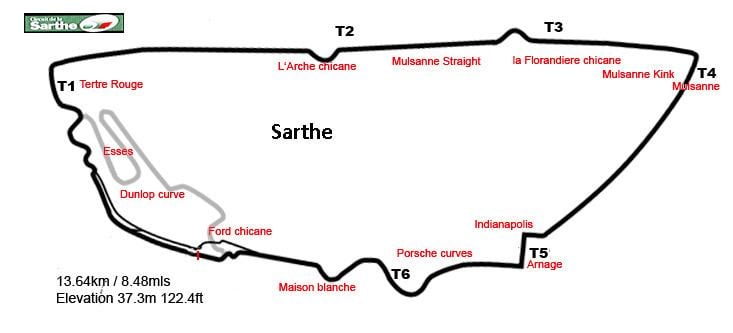 | ||
Owners Automobile Club de l'Ouest, Le Mans Similar Silverstone Circuit, Circuit de Spa‑Francorchamps, Circuito de Jerez, Mugello Circuit, Nürburgring | ||
24 heures du mans 2015 cam ra embarqu e sur le circuit de la sarthe en alpine
The Circuit des 24 Heures du Mans, also known as Circuit de la Sarthe (after the 1906 French Grand Prix triangle circuit) located in Le Mans, Maine, France, is a semi-permanent race course most famous as the venue for the 24 Hours of Le Mans auto race. The track also includes local roads that remain open to the public most of the year. The circuit, in its present configuration, is 13.629 kilometres (8.47 mi) long, making it one of the longest circuits in the world. Capacity of the race stadium, where the short Bugatti Circuit is situated, is 100,000.
Contents
- 24 heures du mans 2015 cam ra embarqu e sur le circuit de la sarthe en alpine
- 24 heures du mans 2016 wec journee test depart 60 equipages circuit de la sarthe
- Track modifications
- Bugatti Circuit
- Speed record
- Race results
- References
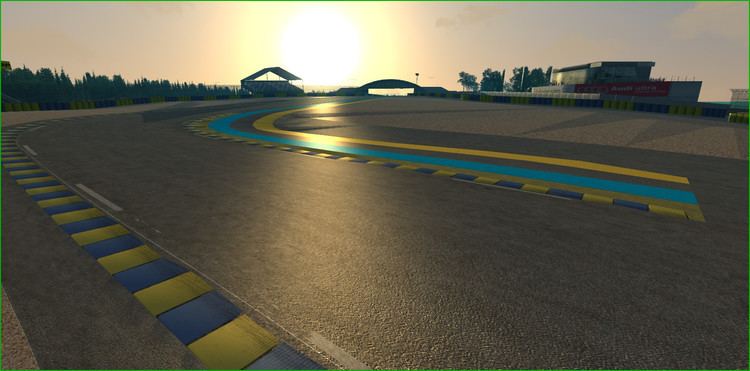
Le Mans is a sportscar race where up to 85% of the time is spent on full throttle, meaning immense stress on engine and drivetrain components. However, the times spent reaching maximum speed also mean tremendous wear on the brakes and suspension as cars must slow from over 200 mph (320 km/h) to around 65 mph (100 km/h) for the sharp corner at the village of Mulsanne.
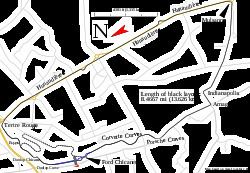
24 heures du mans 2016 wec journee test depart 60 equipages circuit de la sarthe
Track modifications
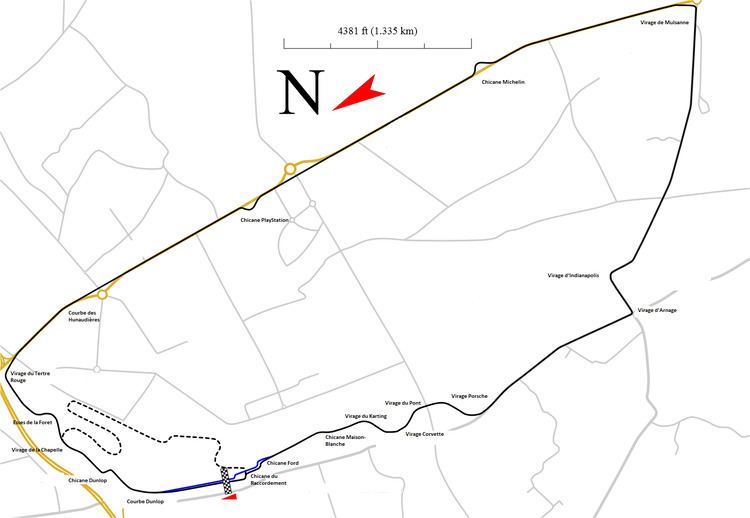
The track, which was a triangle from Le Mans down south to Mulsanne, northwest to Arnage, and back north to Le Mans, has undergone many modifications over the years, with CIRCUIT N° 15 being in use since 2014. Even with the modifications put in place over the years, the Sarthe circuit is still known for being very fast; with average speeds in excess of 230 km/h (140 mph) being achieved by the prototypes.

In the 1920s, the cars drove from the present pits on Rue de Laigné straight into the city, and after a tight right-hander near the river Sarthe Pontlieue bridge (a hairpin permanently removed from the circuit in 1929), left the city again on the rather straight street now named Avenue Georges Durand after the race's founder. Then 17.261 kilometres (10.725 mi) long and unpaved, a bypass within the city shortened the track in 1929, but only in 1932 the city was bypassed when the section from the pits via the Dunlop Bridge and the Esses to Tertre Rouge was added. This classic configuration was 8.369 miles (13.469 km) long and remained almost unaltered even after the 1955 tragedy. Its frighteningly narrow pit straight was narrowed off to make room for the pits and was part of the road itself, without the road becoming wider just for the pits. The pit straight was about 12 feet (3.7 m) wide (the pit straight was widened in 1956) and the race track and pits were not separated for another 15 years. The pit area was modified at a cost of 300 million francs, the signalling area was even moved to the exit of the slow Mulsanne corner, and the track was resurfaced.

With cars getting ever faster in the 1960s, criticism rose, especially when several drivers were killed, often in the testing session in April. Since 1965, a smaller but permanent Bugatti Circuit was added which shares the pit lane facilities and the first corner (including the famous Dunlop bridge) with the longer version. For the 1968 race, the Ford chicane was added before the pits to slow down the cars. The circuit was fitted with Armco for the 1969 race. The Maison Blanche kink was prone to criticism, a number of nasty accidents happened at the very fast kink over the years, such as John Woolfe being killed there in his Porsche 917 in 1969 and three Ferrari 512s (including two works cars) were involved in a pile-up there in 1970, with the latter shunt sealing the very fast classic circuit's fate. The circuit was modified ten more times—in 1971 (a year where the prototypes were averaging over 240 km/h (150 mph), which was also the last year the classic circuit was used) Armco was added to the pit straight to separate the track from the pits, and in 1972, the last part of the race track was revamped considerably—with the quick Porsche curves bypassing Maison Blanche and part of the first straight and all of the second straight between the pits and Maison Blanche. One of the Porsche Curves was affectionately named "Maison Blanche" and a short straight with a slight kink and two chicanes before the pits named the Ford chicanes were all added.
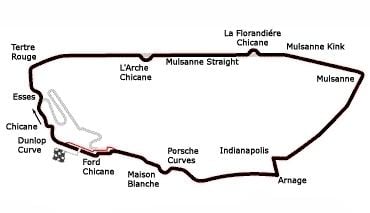
In 1979, due to the construction of a new public road, the profile of Tertre Rouge had to be changed. This redesign led to a faster double-apex corner as well as requiring the removal of the second Dunlop Bridge. In 1986, because of construction of a new roundabout at the Mulsanne corner, a new portion of track had to be built in order to avoid the roundabout. This created a right hand kink prior to Mulsanne corner. In 1987, a chicane was added to the very fast Dunlop curve where cars would go under the Dunlop bridge at 180 mph (290 km/h), now they would be slowed to 110 mph (180 km/h).
In 1990, two chicanes were added onto the Mulsanne Straight (explained in more detail below), and in 1994, the Dunlop chicane was tightened, in 2002, the run to the Esses was revamped because of a reconstruction of the Bugatti Circuit. The Le Mans circuit was changed between the Dunlop Bridge and Esses, with the straight now becoming a set of fast sweeping turns. This layout allowed for a better transition from the Le Mans circuit to the Bugatti circuit. This layout change would also require the track's infamous carnival to be relocated because the area it had once occupied became runoff. The carnival was relocated to the Porsche curves, and in 2006, the ACO redeveloped the area around the Dunlop Curve and Dunlop Chicane, moving the Dunlop Curve in tighter to create more run-off area, while also turning the Dunlop Chicane into a larger set of turns. As part of the development, a new extended pit lane exit was created for the Bugatti Circuit. This second pit exit re-enters the track just beyond the Dunlop Chicane and before the Dunlop Bridge.
Following the fatal crash of Danish driver Allan Simonsen at the 2013 race at the exit of Tertre Rouge into D338, Tertre Rouge was re-profiled again. The radius will be moved in approximately 200m for safety reasons with new tyre barriers at the exit.
Le Mans was most famous for its 6 km (3.7 mi) long straight, called Ligne Droite des Hunaudières, a part of the route départementale (for the Sarthe département) D338 (formerly Route Nationale N138). As the Hunaudières leads to the village of Mulsanne, it is often called the Mulsanne Straight in English, even though the proper Route du Mulsanne is the one from or to Arnage.
After exiting the Tertre Rouge corner, cars would spend almost half of the lap at full throttle, before braking for Mulsanne Corner. The Porsche 917 long tail, used from 1969 to 1971, had reached 362 km/h (225 mph),. After engine size was limited, the top speed dropped until powerful turbo engines were allowed, like in the 1978 Porsche 935 which was clocked at 367 km/h (228 mph). Speeds on the straight by the Group C prototypes reached over 400 km/h (250 mph) during the late 1980s. At the beginning of the 1988 24 Hours of Le Mans race, Roger Dorchy driving for Welter Racing in a "Project 400" car, which sacrificed reliability for speed, was clocked by radar travelling at 405 kilometres per hour (252 mph)). Fatal high speed accidents in the 1980s happened to Jean-Louis Lafosse in 1981 and to Jo Gartner in 1986.
As the combination of high speed and high downforce caused tyre and engine failures, two roughly equally spaced chicanes were consequently added to the straight before the 1990 race to limit the achievable maximum speed. The chicanes were added also because the FIA decreed it would no longer sanction a circuit which had a straight longer than 2 kilometres (1.2 mi)., which is roughly the length of the Döttinger Höhe straight at the Nürburgring Nordschleife.
The fastest qualifying lap average speed dropped only from 249.8 to 243.3 km/h (151 mph) in 1993, and it rose up to 249.2 km/h in 2015, not far from the all time best of 250 and 251 km/h set by the Porsche 917 and 956. Regarding the lap record in the race itself, 2015 saw the fastest ever, with the help of turbos and hybrid power.
Bugatti Circuit
Bugatti Circuit is a permanent race track located within Circuit des 24 Heures, named after Ettore Bugatti. The circuit uses a part of the larger circuit and a separate, purpose-built section. The sections of track on the Bugatti Circuit that are on the Circuit des 24 Heures include the Ford Chicane at the end of the lap, the pit complex, and the straight where the Dunlop Tyres bridge is located. At this point in the overlapping section of the tracks there is a left right sweep that was added for motorcycle safety in 2002. Vehicles turning to the left continue onto the Circuit des 24 Heures, toward Tertre Rouge and Mulsanne, vehicles turning to the right at La Chapelle will continue the Bugatti Circuit. The infield section features Garage Vert, a back straight, the 'S' du Garage Bleu, and Raccordement, which joins back at the Ford chacane.
The track was home base for Pescarolo Sport, founded by famous French driver Henri Pescarolo. The circuit also hosts the 24 Hours of Le Mans motorcycle race, and a round of the MotoGP Championship. The circuit also holds French motor club races and in the past has hosted rounds of the International Formula 3000 Championship and DTM (German Touring Car series).
As well as motor racing it is the venue for the 24 rollers, a 24h race on inline skates or quads.
The Bugatti Circuit was used for the 1967 French Grand Prix, and is the current host of the French motorcycle Grand Prix. It also forms the final round of the FIA European Truck Racing Championship, and was part of the World Series by Renault and 1988 Superbike World Championship seasons.
Speed record
In 1988, Team WM Peugeot knew they had no chance of winning the 24-hour endurance race, but they also knew that their Welter Racing designed car had very good aerodynamics. Thus they nicknamed their 1988 entry "Project 400" (aiming to be the first car to achieve a speed of 400 km/h on the famous straight), although the official team entry was named WM Secateva. Roger Dorchy, Claude Haldi and Jean-Daniel Raulet would be the three drivers that year.
Three hours into the race the team decided to go for it. The plan worked: with Roger Dorchy behind the wheel the WM P87 achieved the speed of 405 km/h (253.125 mph).
The Peugeot retired shortly after that (on lap 59) with an overheating engine. By then it had outlasted two other Group C1 entrants.
Race results
The Le Mans race results in Bugatti and La Sarthe circuit.
